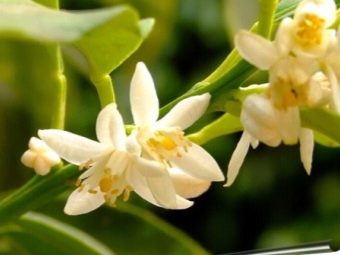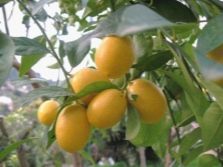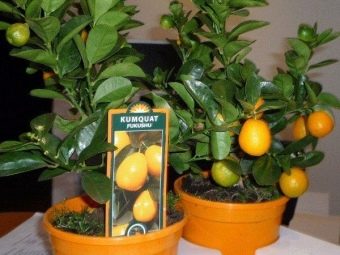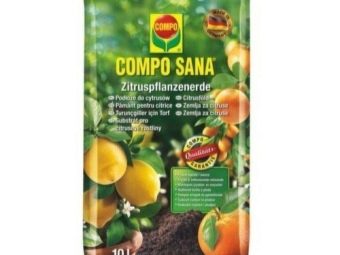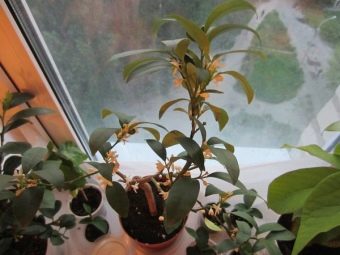Kumquat: what it is and how it looks, its calories and properties
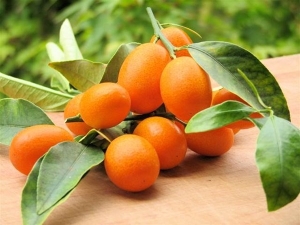
Citrus fruits - oranges, tangerines, lemons and even limes no longer surprise anyone by their presence on store shelves. But the variety of citrus fruits is not limited to them, because there are about 60 species and varieties of this culture. Every day the assortment of citrus is expanding and new, previously unknown fruits appear. One such representative is the kumquat, an unusual exotic fruit, which we will discuss in more detail.
What it is?
Kumquat - an evergreen culture of the genus citrus, family rutovyh. The homeland of growth is China, Japan, the countries of the Middle East. In China, it is Kumquat, that is, “golden apples,” and in Japan it is called Kinkan, which means “golden orange.” In Europe, the kumquat was not known until the beginning of the XIX century, when it was brought there by Portuguese sailors.
Only in the 40s of the XIX century, these small, mandarin-like fruits came to England, where they were described by a Scottish collector - botanist R. Fortunyne. Later, these small fruits, as well as one of the genera of citrus fruits, received the scientific official name "Fortunella". Currently, the kumquat, who loves the sun and moist heat, is growing in numerous humid subtropical countries.
These are the countries of Southeast Asia, China, India, Japan, the Middle East. He gains his popularity in America, the Mediterranean countries. Often it is grown as a decorative tree at home in pots. A tree or shrub Kumquat has a small height (up to 3-4 m) and a lush crown that looks like a ball or a vase. Some species of kinkan on the branches have sharp processes - thorns. Dark green leaves with a smooth edge and translucent veins - dense and small in size. Small as plum fruits (about 2.5 cm in diameter, up to 6 cm long and weighing up to 30 g) have a spherical shape of an elongated oval.
Midsummer - Kumquat flowering time. Its white flowers with five petals exude a delicate, fragrant and pleasant aroma of lime. Fruits, at first similar to berries, appear at the end of autumn - the beginning of winter, and the time of fruiting is winter - spring. Inside, like all citrus fruits, the fruit has slices, the number of which can be from 4 to 7, with several small inedible seeds, bitter in taste.
Smooth thin, but dense skin has a color from light yellow to bright orange. Juicy, aromatic and sweet flesh with its taste resembles tangerine, but with some sourness. The edible skin has a sweet and tart taste and slightly bitter taste, which, together with the pulp, gives the kinkan an unusual exotic taste.
Why are the fruits of different colors?
Often in supermarkets you can see colored dried kumquat: from green to bright red. The natural shade for the kinkan is yellow and orange, and in dried these colors acquire light pale shades. Unscrupulous manufacturers paint their fruits in bright green and red colors, using chemical dyes to make them more attractive. Such kumquat has a chemical smell. Natural dried kinkan has a citrus aroma with a touch of mint.
The color of the kinkan is also affected by its grade. This is usually the fruit of hybrid varieties. Thus, the Limekvat variety, a hybrid of lime and kumquat, has green-tinted fruits that have a bitter-sweet taste of pulp with a strong lime flavor. A "Hong Kong" variety, growing in Hong Kong and China, is distinguished by fruits with skin, the color of which changes from bright orange to red. This red kinkan is inedible. In its pulp of 4 slices are quite large round-shaped bones.
Composition, calorie and fruit properties
Kumquat is a fruit that contains few calories: 71 grams per 100 grams. But it is high in carbohydrates - about 9.4 g, fiber - 6.5 g, and less protein and fat, respectively, 1.9 g and 0.8 g.It should be noted that in dried kumquat, the caloric content increases and is already about 250 kcal per 100 g. In addition, its constituents are monosaccharides, macronutrients: in large quantities potassium, phosphorus, as well as calcium, magnesium and sodium salts. The peel contains elements of copper, manganese, iron, zinc, unsaturated fatty acids, essential oils containing limonene, bergamoten.
Ascorbic acid (vitamin C) predominates among the vitamins in the kinkane, it is about 50%. All vitamin content is represented by vitamins A, E, P, B3, as well as B5 and folic acid (vitamin B9). It combines other necessary substances: saturated and unsaturated fatty acids, antioxidants, pectin, carotene, lutein. In addition, the fruit has such a remarkable ability - not to consume nitrates from the soil, which means they are not contained in its fruits.
Benefits and healing properties of kumquat were discovered by healers in ancient China, especially its antimicrobial properties. Even then, diseases of the fungus juice or kumquat gruel were treated. Use his antifungal action now.
This baby fruit, owning such a large supply of nutrients, is endowed with a huge range of beneficial effects on the human body.
- It has antimicrobial properties. If you regularly consume the kinkan, it increases the body's resistance to various infections of viral, bacterial or fungal origin and strengthens the immune system.
- It has a hematopoietic and strengthening effect on the cardiovascular system. Elements of metals and folic acid are involved in the formation of red blood cells, and a high content of potassium normalizes cardiac activity, reducing the possibility of stroke.
- Leads to normal blood pressure.
- Lowers cholesterol.
- Normalizes digestion due to fiber, stimulating the bowels. Vitamin C improves the functioning of the liver by breaking down fats. It prevents the occurrence of gastric and intestinal ulcers.
- Cleans the body from harmful substances. The antioxidants contained in it neutralize the action of toxins and remove them from the body. Has a beneficial effect after taking alcohol and fatty foods, quickly removes a hangover.
- Strengthens the overall condition of the body, saturates it with vitamins, warning avitaminosis.
- Essential oils have stimulating effect on brain activityfor this, the kinkan gained the reputation of the “food of the sages”, and besides, it removes mental exhaustion.
- Due to the content of retinol (vitamin A) and beta-carotene protects against cataracts and improves eyesight.
- It has a preventive effect against type 2 diabetes., as the dietary fibers of the kinkan regulate the content of monosaccharides and insulin.
- Helps in the treatment of dry cough, rhinitis and serves as the prevention of influenza during its epidemic (used for inhalation of oils or decoction of the peel, as well as a mixture of fruit with honey).
- Helps to get rid from toxicosis in early pregnancy.
- Has a calming effect, normalizing and restoring the activity of the nervous system due to the content of vitamins B3 and B5, and ether oils help to cope with depression and depressed mood. In this case, use aromatherapy using kumquat oils. The peel on warm radiators does not only disinfect the room, but also creates the conditions for a good sleep.
- Apply it in cosmetology. The fruits of kinkan are one of the ingredients of many face masks that prevent aging and the appearance of wrinkles, peels for skin problems. Creams, lotions with the content of essential oils of kumquat help get rid of postpartum stretch marks, cellulite and pigment spots.
- Is an energy resource of the bodySince it contains a large amount of carbohydrates, it perfectly satisfies hunger, and the presence of riboflavin ensures the restoration of energy reserves.
- How low-calorie fruit used in diets as a high content of water, dietary fiber and carbohydrates quickly creates a feeling of fullness, not allowing to overeat.
The benefits of dried and dried kumquat are not less than those of fresh ones, since the nutrients in it do not disappear. In the peel even its antibacterial and antiviral properties are enhanced. It is recommended to use it during recovery after an illness for replenishment of energy resources and improving the body tone.
Along with the great benefits, the kinkan can also cause some harm. So, with gastritis, peptic ulcer and high acidity, its use can lead to exacerbation of the disease. It is not recommended to use the fruit in inflammatory processes in the intestine and in kidney diseases. Like all citrus fruits, it can cause allergies in people who are predisposed to it.
In diabetes, its use should be very careful and only after medical consultation. Overweight people are not recommended to abuse them, as the product contains a lot of carbohydrates. Kumquat can be given to children only after the age of three. It is not recommended to use it in pregnant women after a three-month period and when breast feeding a baby, as this may affect the development of allergies in the child.
How to eat and what is prepared from it?
Although kumquat has healing qualities, it is used as a dessert, not as a remedy. Only a ripe kinkan can be a real pleasure, therefore it should be chosen carefully. When buying, you need to take not too hard, but elastic fruit. The hardness of the peel indicates immaturity, and too soft indicates over-ripeness or that the fruit is already deteriorating.
Pay attention to the peel: in the ripe kinkan it is golden-orange. On the peel should not be any spots, scuffs, plaque or cracks. It is advisable to choose fruits with a stem, this suggests that they were collected correctly. When choosing dried kumquat, preference should be given to fruits of a light yellow color, which indicates its naturalness. The colored fruits have bright colors: red, yellow, green and orange.
At the sight of this miniature "golden orange" for those who have not tried it yet, the question arises how to eat it, whether it is necessary to peel the skin. The answer is simple - only with the peel, because it is in the combination of the taste nuances of the peel with the pulp that this inexpressible exotic taste arises.
Before eating, the kinkan should be washed and kneaded slightly so that the ether oils contained in its peel penetrate into the fetus. Feel and appreciate the juiciness and unusual taste scales (sweetness with a slight sourness of the flesh and honey rind with a slight bitterness aftertaste) is available when you eat fruit with skin.
Kinkan eat optional fresh. The stores also sell it in dried and dried form, this fruit has retained all its beneficial qualities. When choosing dried fortunella pay attention to its color. Bright green, red and yellow colors indicate that the fruits are colored. The color of natural dried kinkan has light shades of yellow and orange.
Fortunella is widely used in cooking. From it boil wonderful jam, delicious jams, marshmallow and marmalade. Spicy and sweet sauce, spicy or sour sauces will improve and accentuate the taste of meat dishes, pilau, chicken. Apply it as an ingredient for salads, season it with puddings and porridge. When roasting poultry and fish in the oven, a kinkan cut into circles will add an elusive, fragrant smell.
It will also give a savory taste to vegetable stews and seafood. Fortunella serves as a decoration for cakes, an addition to biscuits and ice cream, and cottage cheese and yoghurt will only get better with fruit. Compote is boiled out of it and squeezed out of juice. And dishes prepared for the festive table, decorated with kumquat, acquire beauty and elegance. In the bars it serves as a snack for alcohol: vermouth, wines, liqueurs and martini.
Kinkan produces delicious candied fruits that are superior to other dried fruits. Whole fruits are boiled in syrup, dried, and then placed in powdered sugar. But to abuse the fruits in sugar is not worth it, as they contribute to weight gain. In China, it is widely used in dried form, dipping in honey and squeezed tea. Or they brew black or green tea with it, which not only acquires a special aroma and flavor, but is also very useful.
Here are some recipes for kumquat.
- Compote from fresh fruits. 250 g of fruit you need to take a glass of sugar and two liters of water. Cut the pure fruits into pieces, remove the seeds, add water, bring to a boil and cook for about half an hour. A few minutes before the end of boiling add sugar, cinnamon as desired.
- Sweet sauce. Pour half a glass of sugar into water (250 g) and prepare a syrup. In this syrup, they put crushed seedless fortunella and cinnamon (1 stick) and keep it on fire until the fruit becomes transparent (about 30 minutes). Sweet gravy can pour curd, pudding, ice cream.
- Sauce for meat dishes. Cut 300 g of kinkan, add to it dry white wine (100 g) and sugar (2 tablespoons) - extinguish everything on low heat until the liquid evaporates. This sauce will emphasize the taste of lean meat, chicken.
Eating fresh Fortunella, you need to remember that it can not be abused: 2-3 fruits a day are enough to replenish your vitamin and energy reserves.
What are plant varieties?
Kumquat is bred not only for growing crops, but also as a decorative ornament of summer cottages and even in an apartment. This unusual fruit, combining the flavor nuances of orange, tangerine and lemon, has the following varieties.
- "Margarita" or "Nagami" is the most popular among other varieties. It is an evergreen tree or large shrub with a rounded crown and dense foliage. It grows slowly. The period of fruiting in this variety is large - throughout the year. "Margarita" is cold-resistant and even tolerates frosts. However, sweet fruits ripen only under warm and humid conditions. It blooms with white flowers with a fragrant odor. In its color and texture of the peel, the fruit is very similar to orange, but their size is small, like a large olive. Unusual contrast of taste is created by sweet peel and tender sour pulp, exuding aroma of lemon.
- Grade "Maeve" - A hybrid of natural origin from the varieties "Nagami" and "Marumi". The bonsai has a dense and lush crown of dense small leaves and looks very beautiful. It blooms in summer, and ripening occurs at the end of the winter months. The variety is not as cold-resistant as "Nagami", but also safely tolerates sub-zero temperatures. Fruits are round or oval in shape and are considered the sweetest of all other kinkans, with soft juicy flesh and skin, though rather thick, but very sweet. In the pulp there are not so many pits, there are even fruits without them at all. In size, they are slightly larger than normal and resemble a lemon with their golden yellow skin.
- Fukushi. This sort of fruit is even larger than that of “Maeve”. A dwarf-type tree reaches a height of about one meter, and the branched crown is very dense with larger leaves than other kinkans. Fruits can have not only rounded, but also pear-shaped. Orange sweet thin peel covers very juicy pulp.
- "Variegated". Artificial variety. Kumquat "variegated" - undersized tree with dense foliage, branches without thorns. Its leaves have an unusual color - light yellow or cream, and the fruit has a pale yellow and light green strip, which disappears as it ripens. The peel of ripe fruit is orange. Oblong fruits ripen in winter and have a juicy, but sour orange-bright flesh.
- "Malay" owes its name to the place of growth - Malaysia.Malay kumquat is slightly higher and grows to 5 meters. The leaves are long and pointed, dark green. Its spherical large fruits are covered with a golden-orange glossy and smooth skin. It is a thermophilic culture and does not tolerate cold.
- Among the decorative varieties of kumquat can be noted "Hong Kong" variety, common in Hong Kong and China as a wild plant. There is a cultural appearance of this variety. “Hong Kong” kumquat is most often used to form bonsai gardens, as it has dwarf growth and cannot be more than one meter. Its inedible orange, turning into a red color fruits the size of a pea or bean - the smallest among this type. The incompetent flesh contains large bones. In China, it is often used as a seasoning for dishes.
In addition to these varieties, there are also hybrid species created by breeding with other types of citrus fruits: limequat - hybrid with lime, orangeback - orange hybrid, calamondin - tangerine hybrid.
Tree growing tips
Amateur flower growers always strive to diversify and replenish their collection of house plants with all new species. Currently, Kumquat has become increasingly popular. Growing up at home, he will decorate the interior with the decoration of his magnificent crown. Kumquat can be propagated by various methods: using seeds, cuttings, cuttings and plant on a stock. You can grow a kinkan from seed by adhering to the basic rules of care.
It is important to choose the right soil. You can buy soil for citruses in the store, and you can prepare it. The soil for Fortunella should contain garden soil, yellow sand (pre-steamed in the oven), taken in the same proportion, as well as a little compost. This mixture is filled with a flat dish, having previously placed on the bottom of the drainage a layer of up to 7 cm.
For the selection and preparation of seeds, seeds are selected only from fresh, perfectly ripened fruits. Such bones have a dark shell. The seeds are well washed with warm water, removing all the remnants of the pulp, and put in a container of water on natural fabric (gauze) and kept for a day. It is advisable to add the drug "Epin", which stimulates growth, and to control the moisture of the fabric, preventing it from drying out.
For sowing in saucers, the soil is slightly watered, the seeds are deepened in the soil by 2 cm and fall asleep. For safety, you need to sow a few kernels, you can remove extra and weak shoots later. After sowing, the dish is covered with polyethylene and placed in a warm place where strong light does not reach. They create a temperature regime of at least +20 degrees. The earth in flames should be kept constantly wet, but not too wet, otherwise the seeds simply rot. Seeds will grow after about 1-1.5 months, then the film is removed for aeration of seedlings. Now the dish should be placed closer to the light, preferably on the south side.
Picks are done when real leaves appear (4 pcs.), Each sprout is planted in a separate bowl. The larger the container for the plant, the larger the grown kumquat will be. Transplantation must be very careful not to damage the still weak roots. To do this, the plant is removed, keeping a clod of soil, placed in a new dish and watered.
Another type of kinkan breeding is through cuttings. They can be taken all year from a fertile adult kumquat, but spring is a better time. The length of the cutting should be from 7 to 10 cm and have 2-3 buds. Sections at the bottom of the cutting are treated with charcoal powder to prevent their rotting. Then they are put in the water, adding "root", stimulating the growth of roots.
Leaves should be cut to a third (or 2 thirds, if they are large). The cuttings are put into earthen mixture or perlite (vermiculite), dipping in by 3 cm. Seedlings need to cover a glass of plastic and the resulting simplest greenhouse placed in a warm place, it is desirable that the light was diffused.The roots will germinate in about two months, and the seedling can be planted in a bowl.
Growing fortunella using layering is also possible. To do this, on a one-year shoot or a branch of a tree, preferably fruiting, the bark is incised in the form of a ring 10 cm from the trunk. The bark is removed from this incision. Leaves growing before and after an incision are pruned. An improvised “plate” is made from a small plastic bottle to cover the cut.
For this, the bottle is cut in half lengthwise, parts with a bottom are cut off from it so that their length is longer than the cut length. Then, in the bottom of each part of the bottle, plastic is cut off in the form of a semicircle, equal to the diameter of the branch. These parts are tied to a branch so that the incision is in the middle of the “bowl”. Both halves are fixed with each other, filled with moist soil and constantly support it. Two months later, the branch of kumquat is cut below the "bowl", part of the bottle is removed. The graft with a lump of soil is transplanted into the pot.
For propagation by grafting, grown seedlings are needed, having a base thickness of about 1 cm. The grafting is done during the period of active vegetation. Apply a kind of vaccination in the butt flap, as well as the usual budding kidney cultivated varieties. Approximately 6 weeks later, the kidneys survive. Seedling pruned to graft. Reproduction using layouts and vaccinations are very complex methods that require special knowledge and experience.
Fortunella is a moisture lover, so it needs to be watered regularly, the soil should not be dry. In the summer, watering is done daily with warm, settled water. Winter irrigation can be limited once a week.
Air humidity is also very necessary for Fortunella. Everyday water sprays from a spray bottle will benefit her. It is good to put a container with water near it, such evaporation will increase the humidity of the air.
The plant should be in a sunny place. In winter, when there is a shortage of solar lighting, it is necessary to additionally illuminate the plant with phytolamp. In the summer, it is recommended to bring Fortunella out to air. The young kumquat grows annually, and the increments occur twice in a year by about 6–8 cm. The trunk of an older kinkan is cut, leaving it 20 cm high and retaining at least 4 developed buds. Of them subsequently grow shoots, which will become the basis of the crown. Subsequent shoots are shortened by approximately 5 cm.
And adult kinkans intensively grow in April-May. To make a beautiful decorative appearance in spring, it is necessary to cut the shoots from the sides, forming a crown in the shape of a ball. On the main branches leave no more than 3 shoots, all unnecessary pruned. The remaining a little cut the tops, causing the growth of new shoots.
As a top dressing, you can apply universal ready-made nutritional mixtures. During growth (spring-summer) it is necessary to fertilize monthly three times. In autumn and winter they feed up in one and a half to two months. The usual nutritional mixture for kinkan includes such components: four grams of ammonium nitrate and potassium salts and 10 g of superphosphate. This mixture is poured over two liters of water.
Replanting adult fortunella is recommended once every 3 or 4 years. It is better to carry out a spring transplant before the development of shoots. It blooms by the 4th year of life somewhere in July, and after a fortnight it may bloom again. Fruit ripening occurs in winter. Although the kinkan is a bisexual species, when two plants are planted, the likelihood of fruit is obtained due to cross-pollination.
Kumquat, like all citrus fruits, is prone to various diseases. This is indicated by such signs.
- The appearance of spots on the foliage. This indicates fungal or viral infections, such as hommoz, wart, anthracnose. The buds or the fruits that appear are removed, and then the tree is treated with fungicides by spraying several times. With the preventive purpose you need to spray the Bordeaux mixture (1%) up to three times during the growing season.
- Changes in shape and color of the leaves.
- Drying plants.
- Formation of growths.
Harmful insects can cause harm to Fortunelle: aphid, shieldweed, spider mite. In this case, the tree must be treated with insecticides.
And finally, use the valuable advice of experienced gardeners and gardeners.
- When transplanting kumquat, you need to carefully inspect the roots, removing dried and diseased ones, as well as identifying fungal damage.
- The temperature regime for Fortunella should be up to +30 degrees for summer time, and + 14-17 in winter.
- No need to put a stump wherever a draft can occur - the plant does not like it.
- It is not necessary to frequently spray water with Fortunella at temperatures below +18 degrees in winter to avoid the occurrence of fungal infections.
- In autumn and spring, watering a tree is recommended moderately and in the morning - it is more effective.
Decorative tree Kunkan decorate any apartment during the fruiting period, when bright orange fruits stand out on a dark green crown. And during the period of flowering, Fortunella, covered with beautiful white flowers, will fill the apartment with an unusually pleasant aroma.
For tips on growing kumquat at home, see the video below.



